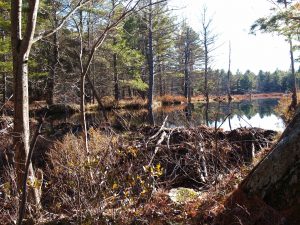A REAL EMBLEM NOW October 1975
Just about everyone who has gone to school in Canada, indeed even those who obtained their schooling elsewhere, were aware that the beaver was considered to be Canada’s national animal. True, we had the Maple Leaf, “Our Emblem Dear” as Alexander Muir called it in the fine song, but the beaver appeared on a great many things, and was considered our special emblem. Only thing, it was not officially recognized until this year, 1975.
Several short articles appeared in various news media mentioning the fact that while all of us considered the beaver to be our emblem, or one of them, it had never been recognized by the powers that be down in Ottawa.
This oversight was brought to the attention of our own member of parliament, J. Stanley Darling of Burks Falls who promised to do something about it. As a result he introduced a bill that would rectify a little thing that had been overlooked three hundred years ago. Trouble was the Prime Minister called an election before the bill was passed.
Then came the report from New York State informing us that they intended to have the beaver as their state emblem. Then Oregon announced that the beaver had been their emblem for many years.

A bill was presented, and passed without a single dissenting voice, establishing our most popular animal as “an” emblem of Canada. I do not suppose that anyone felt any differently, as we were so used to calling it our emblem, but it is good to know that it is official.
The beaver was well chosen. It is found in every one of the ten provinces as well as the Yukon and the Territories. It has demonstrated that it can make a comeback, or several of them under the most adverse conditions they returned to such numbers, in spite of heavy trapping, that in some areas they were and still are considered to be a nuisance.
It was the discovery of the beaver, not to mention other fur bearing animals that sent explorers into all parts of the newly found place they called Canada. It was the quest for all fur but mainly beaver that made it possible for a group of men in England to form “The Company of Gentlemen Adventurers, Trading into the Hudson Bay.” Now of course it is known as the H.B.C., or Hudson Bay Company.
Early records in the company archives in Montreal indicate that the natives couldn’t read, so the H.B.C. chose two colours, red and white, and anything wrapped or tied with those colours was H.B.C. property.
Beaver were the standard of exchange. Everything else was graded as compared with the price of a beaver skin. Approximately, for one beaver it required two otter; for one beaver it also took four mink, also marten. For fisher it took three, and I believe three lynx. Then these furs were all recorded as beaver, though some parcels were marked “made beaver”, meaning other furs graded to represent so many beaver. While there were a great many furs being taken all over Canada they were not shipping as many pelts as are handled in one year at the O.T.A. sales in North Bay.
Firearms were very crude but since they were an improvement over the bow and arrow the natives wanted them. These guns were not much more than a piece of gas pipe with a flint lock and a stock. Buyers were obliged to produce as many beaver hides piled flat that would be as high as the firearm which was about five feet in length. It would take perhaps four hundred beaver skins.
Hunters and trappers have been blamed for lack of beaver but biologists have discovered that the disease tularemia will wipe them out. When beaver have been left too long it occurs killing the beaver in that area. Just nature’s way of keeping a balance. Beaver in our Algonquin section have been quite numerous and many have been harvested. Last fall an air survey estimated about 2.30 beaver per square mile. The beaver harvest came at 2.26. However, the quota was not taken. Trappers, registered, farmers, and those that trap on private grounds were given a quota of 8,631. Returns show that 5,562 were harvested; just about 65%. This is above the provincial average.
Beaver have been the mainstay of the fur harvest for some years. This year they are in danger of being replaced by the raccoon which is becoming very numerous and are in heavy demand on the market. But the beaver is here to stay. Sensible harvesting has produced many pelts and leaves plenty of good breeding stock. And it is good to know that now they really are an emblem of our own Canada.